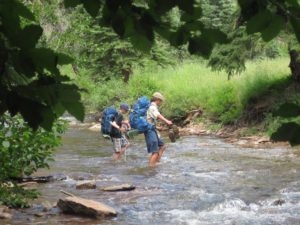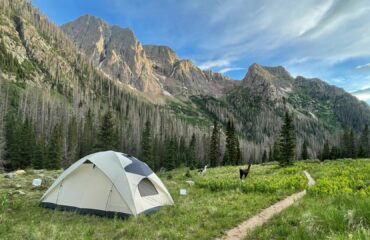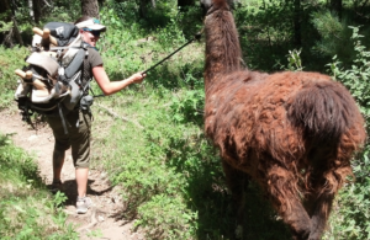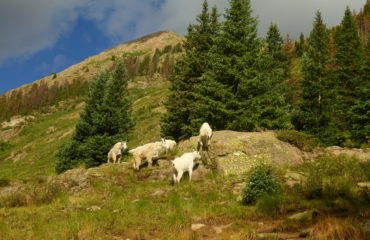Ah, the thrill of the wilderness! The mountain vistas! The serene lakes! The smell of the spruce trees! The aching back and feet! The soggy sleeping bag! Wait… hang on… these things don’t have to go hand in hand when you are backpacking. With thousands of miles under a pack and trips in every month of the year, I’ve learned things the hard way so you don’t have to.
Pack your pack correctly
A properly packed pack can make a huge difference in comfort.
– Least dense items go in the bottom. (Sleeping bag, mat)
– Medium density item go in the middle. (Tent, clothes)
– Densest items go on the top or closest to your back. (Water, fuel, toiletries, tent poles, stakes)
– Compress, compress, compress! A loose load will wobble.
– Avoid strapping items to the outside that might swing around.
– Be sure to keep important items accessible such as snacks, bug spray, and rain gear.
Keep your stuff dry
– Store your sleeping bag and puffy coat in a drybag AND use a pack cover or line your pack with a heavy duty trash bag. This is a good idea for defense against both rain and creek crossings. Don’t think you are so nimble that you will never fall in a creek!
– A lightweight trekking umbrella can be a sanity saver! It’s especially handy when there is intermittent sun and rain. Stopping every five minutes to put on or take off your rain jacket might drive you crazy. An umbrella is also portable shade.
– Dry socks are like gold. Bring a pair of socks that will only be worn in your tent. This makes for dry, happy feet.
Keep your luxury items to a minimum
I have seen some VERY large packs on the trail with some VERY tired hikers beneath them. Once a hiker was carrying full sized camp chairs. He told me that many years ago his backpacking mentor advised him to bring everything that he would need to be comfortable at camp.
I believe the opposite is true. If you have a lighter pack, you will be less fatigued at camp and therefore won’t need as many luxuries. All these little items add up. By the time you pack a hammock, seat, playing cards, umbrella, full tube of toothpaste, too many wet wipes, water bottle full of wine, and mini pillow, you’ve added 7 pounds to your pack.
If you’re not trying to pack super light, a goal weight for your pack for 3 days should be 30 pounds including food and water. This will also help you go farther.
Choose your camp wisely
– Water – Sleeping next to a babbling brook lulls me to sleep and rocks me like a baby all night long. But camping in a deep river valley can be miserable in the morning. The colder air sinks down to the bottom and dew can condense so much that you may wonder, as you greet the crystal blue morning sky, if you slept through a rainstorm. It is amazing how much warmer and dryer things can be just a short ways up slope. You will also be farther from mosquitoes.
– Morning Sun – Higher camps also mean more sunshine. With summer temps in the Colorado mountains regularly dipping into the 40s, a ridge camp can be delightful even if water access is challenging. When choosing a camp, get out your compass to see if you have a clearing where the sun will rise. In early summer, the sun rises in the northeast (51 degrees). At the fall and spring equinoxes, it is due east. If you are brave enough for winter camping, the sun rises in the east southeast in late December (116 degrees). You can calculate exact bearings at http://aa.usno.navy.mil/data/docs/AltAz.php.
 Bring hiking poles
Bring hiking poles
Let your arms help your legs. Some people think that poles are for old people but I think they are for smart people.
Wear your favorite footwear
I’ll spare you from the entire history of backpacking footwear, but 50 years ago, 8 inch high boot tops and rigid boot soles were all the rage. These days, you’ll find folks hiking 500 miles in a pair of trail running shoes or even sandals. The point is, not everyone needs a ton of ankle and foot support. Wear what makes your feet happy. You needn’t wear big heavy boots just because your backpacking mentor told you to.
Author MK Gunn is the education and program assistant for San Juan Mountains Association (sjma.org). She is currently on track to backpack in every month of 2016.
(Picture caption: Well packed packs help you to be more stable.)



